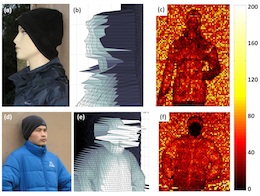Applications include imaging man-made targets such as moving vehicles
A team of Scotland-based physicists said they have developed a new laser scanner with the potential in five years to scan and 3D image objects more than six miles away.
A new study in the Optical Society’s (OSA) open-access journal Optics Express, describes a time-of-flight (ToF) imaging system that today has the ability to gather 3D information about objects, such as items of clothing that do not easily reflect laser pulses, from more than a half mile away and resolve depth on the millimeter scale over long distances using a detector that “counts” individual photons.
Although other approaches can have exceptional depth resolution, lead author and Heriot-Watt University Research Fellow Aongus McCarthy said the scanner would be useful in a variety of applications, but the primary use of the system is likely to be scanning static, man-made targets such as vehicles. With some modifications to the image-processing software, it could also determine their speed and direction, he said.
“Our approach gives a low-power route to the depth imaging of ordinary, small targets at very long range,” McCarthy said. “While it is possible that other depth-ranging techniques will match or out-perform some characteristics of these measurements, this single-photon counting approach gives a unique trade-off between depth resolution, range, data-acquisition time, and laser-power levels.”
The laser light has a wavelength of 1,560 nanometers, meaning it is longer, or “redder,” than visible light, which is only about 380-750 nanometers in wavelength. The long-wavelength light travels more easily through the atmosphere, is not drowned out by sunlight, and is safe for eyes at low power. Many previous ToF systems could not detect the extra-long wavelengths that the Scottish team’s device is specially designed to sense, the study said.
The scanner is particularly good at identifying objects hidden behind clutter, such as foliage, the paper said. However, it cannot render human faces, instead drawing them as dark, featureless areas. That’s because at the long wavelength used by the system, human skin does not reflect back a large enough number of photons to obtain a depth measurement. However, the reflectivity of skin can change under different circumstances.
“Some reports indicate that humans under duress—for example, with perspiring skin—will have significantly greater return signals” and produce better images, McCarthy said.
Outside of target identification, photon-counting depth imaging could be used for a number of scientific purposes, including the remote examination of the health and volume of vegetation and the movement of rock faces, to assess potential hazards, according to the study.
Next steps for the team include making the scanner work faster. Although the data for the high-resolution depth images can be acquired in a matter of seconds, currently it takes about five to six minutes from the onset of scanning until a depth image is created by the system.
Most of that lag, McCarthy said, is due to the relatively slow processing time of the team’s available computer resources.
“We are working on reducing this time by using a solid-state drive and a higher specification computer, which could reduce the total time to well under a minute. In the longer term, the use of more dedicated processors will further reduce this time,” he said. “It is clear that the system would have to be miniaturized and ruggedized, but we believe that a lightweight, fully portable scanning depth imager is possible and could be a product in less than five years.”
The research was funded by the United Kingdom’s Engineering and Physical Sciences Research Council.






